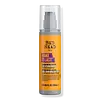What's inside
What's inside
 Key Ingredients
Key Ingredients

No key ingredients
 Benefits
Benefits

 Concerns
Concerns

 Ingredients Side-by-side
Ingredients Side-by-side

Water
Skin ConditioningSodium Laureth Sulfate
CleansingSodium Lauryl Sulfate
CleansingGlycol Distearate
EmollientDimethicone
EmollientCocamidopropyl Betaine
CleansingCetyl Alcohol
EmollientBetaine
HumectantCocamide Mea
EmulsifyingGlyceryl Oleate
EmollientParfum
MaskingGuar Hydroxypropyltrimonium Chloride
Skin ConditioningBenzyl Alcohol
PerfumingSodium Chloride
MaskingDisodium EDTA
Malic Acid
BufferingLaureth-23
CleansingLaureth-4
EmulsifyingGlycine
BufferingPolyquaternium-7
Tocopheryl Acetate
AntioxidantSimmondsia Chinensis Seed Oil
EmollientHydrolyzed Keratin
HumectantPPG-9
Skin ConditioningMethylchloroisothiazolinone
PreservativeSodium Hydroxide
BufferingMethylisothiazolinone
PreservativeLinalool
PerfumingHexyl Cinnamal
PerfumingButylphenyl Methylpropional
PerfumingLimonene
PerfumingWater, Sodium Laureth Sulfate, Sodium Lauryl Sulfate, Glycol Distearate, Dimethicone, Cocamidopropyl Betaine, Cetyl Alcohol, Betaine, Cocamide Mea, Glyceryl Oleate, Parfum, Guar Hydroxypropyltrimonium Chloride, Benzyl Alcohol, Sodium Chloride, Disodium EDTA, Malic Acid, Laureth-23, Laureth-4, Glycine, Polyquaternium-7, Tocopheryl Acetate, Simmondsia Chinensis Seed Oil, Hydrolyzed Keratin, PPG-9, Methylchloroisothiazolinone, Sodium Hydroxide, Methylisothiazolinone, Linalool, Hexyl Cinnamal, Butylphenyl Methylpropional, Limonene
Ingredients Explained
These ingredients are found in both products.
Ingredients higher up in an ingredient list are typically present in a larger amount.
Disodium EDTA plays a role in making products more stable by aiding other preservatives.
It is a chelating agent, meaning it neutralizes metal ions that may be found in a product.
Disodium EDTA is a salt of edetic acid and is found to be safe in cosmetic ingredients.
Learn more about Disodium EDTALimonene is a fragrance that adds scent and taste to a formulation.
It's found in the peel oil of citrus fruits and other plants such as lavender and eucalyptus. The scent of limonene is generally described as "sweet citrus".
Limonene acts as an antioxidant, meaning it helps neutralize free radicals.
When exposed to air, oxidized limonene may sensitize the skin. Because of this, limonene is often avoided by people with sensitive skin.
The term 'fragrance' is not regulated in many countries. In many cases, it is up to the brand to define this term. For instance, many brands choose to label themselves as "fragrance-free" because they are not using synthetic fragrances. However, their products may still contain ingredients such as essential oils that are considered a fragrance.
Learn more about LimoneneParfum is a catch-all term for an ingredient or more that is used to give a scent to products.
Also called "fragrance", this ingredient can be a blend of hundreds of chemicals or plant oils. This means every product with "fragrance" or "parfum" in the ingredients list is a different mixture.
For instance, Habanolide is a proprietary trade name for a specific aroma chemical. When used as a fragrance ingredient in cosmetics, most aroma chemicals fall under the broad labeling category of “FRAGRANCE” or “PARFUM” according to EU and US regulations.
The term 'parfum' or 'fragrance' is not regulated in many countries. In many cases, it is up to the brand to define this term.
For instance, many brands choose to label themselves as "fragrance-free" because they are not using synthetic fragrances. However, their products may still contain ingredients such as essential oils that are considered a fragrance by INCI standards.
One example is Calendula flower extract. Calendula is an essential oil that still imparts a scent or 'fragrance'.
Depending on the blend, the ingredients in the mixture can cause allergies and sensitivities on the skin. Some ingredients that are known EU allergens include linalool and citronellol.
Parfum can also be used to mask or cover an unpleasant scent.
The bottom line is: not all fragrances/parfum/ingredients are created equally. If you are worried about fragrances, we recommend taking a closer look at an ingredient. And of course, we always recommend speaking with a professional.
Learn more about ParfumWater. It's the most common cosmetic ingredient of all. You'll usually see it at the top of ingredient lists, meaning that it makes up the largest part of the product.
So why is it so popular? Water most often acts as a solvent - this means that it helps dissolve other ingredients into the formulation.
You'll also recognize water as that liquid we all need to stay alive. If you see this, drink a glass of water. Stay hydrated!
Learn more about Water